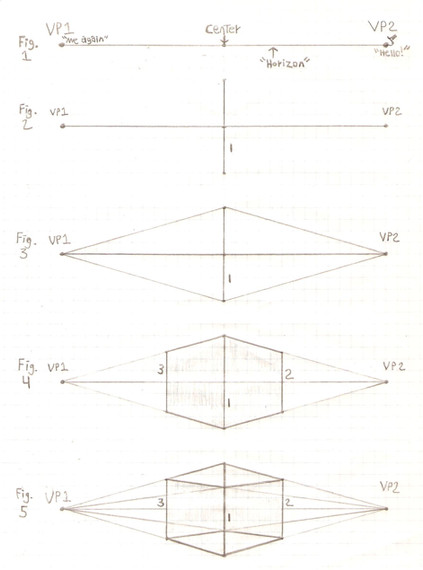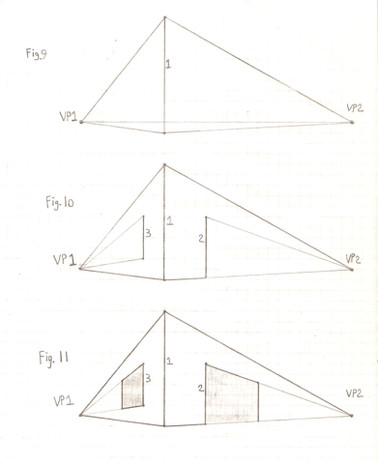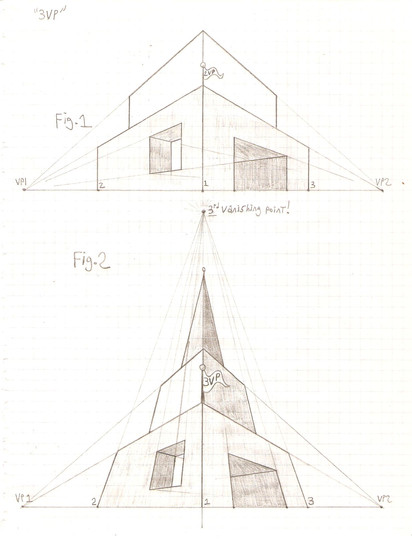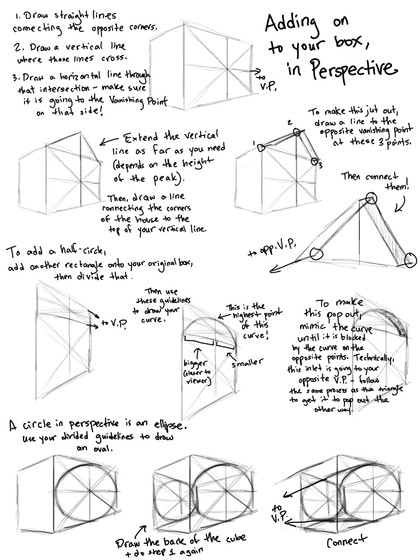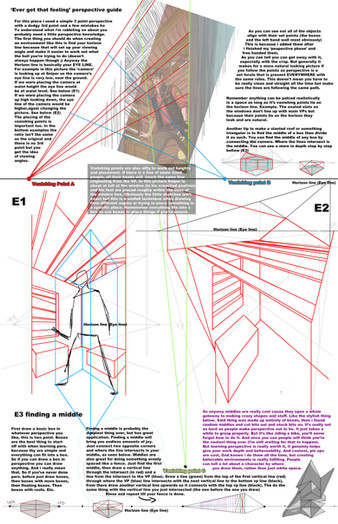HOME | DD
 GriswaldTerrastone — Perspective Tutorial: Independent 2 VPs
GriswaldTerrastone — Perspective Tutorial: Independent 2 VPs

Published: 2012-03-19 21:27:05 +0000 UTC; Views: 6228; Favourites: 66; Downloads: 124
Redirect to original
Description
So far, you've seen the world of the 1VP, the world of the one single vanishing point.Coming up on the horizon is the world of the 2VP.
But between the two is something that has two vanishing points...yet is not really a 2VP image.
Like this.
Fig. 1 shows a typical 1VP image. Depth is handled by the single vanishing point. As it is low, this implies that your point of view is relatively low. But there is nothing unusual about this; the dimension of depth is handled by that vanishing point. Nothing else is angled; this is a "straight on" view, which is what 1VP images are mostly about.
But, now...
Fig. 2 is different. Once again you have that vanishing point, just as before...but wait- now there is a SECOND vanishing point, up above the buildings. What's more, the fronts of the buildings, as well as the window and doorway frames, are affected, now the sides all slope up to that second vanishing point.
It is as if you are looking at floors going off into the distance, but this time it is up, not simply away from you- because that first vanishing point handled the "off into the distance."
Two things happening at once.
Two vanishing points, working independently of each other each showing something going off into the distance- one up, one away. Take a moment to see what each one is doing.
As you will see very soon, a typical 2VP image involves angled buildings and objects, or "corner views." 1VP images have "straight on" views, which is why the sense of depth is so strong with them.
(It could be said that, if you turn Fig. 2 on its side then it is more clearly a 2VP image, with the objects over one of the vanishing points. Yet, it just doesn't have the look or feel of 2VP; it just seems different somehow.)
If you wanted to show something going upwards (or downwards) with a 2VP image, you'd need the third vanishing point, making it a 3VP image...but more on that later.
But for a 1VP image, that second VP actually acts like a third VP would. This is how you add that extra dimension to a 1VP image.
You'd use this for a straight-on view of tall buildings, or a giant robot (imagine the side buildings as feet).
Between the two worlds. A stepping stone or bridge.
Related content
Comments: 5

something to consider:
1 point perspective picture is looking down one of the axes. (standing on a compass looking south for example.)
2 point perspective is looking between axes (looking between south and west.)
3 point perspective is looking between axes and not at the horizon. (looking up or down between south and west.)
What you have in figure 2 is a 3 point perspective drawing... but looking above one of the axes, creating a combination of 1 and 3 point perspective.
👍: 0 ⏩: 1

When defining perspective, I tend to consider two things: what is a "typical" view, and how many vanishing points are being used. For example, in the figure you are mentioning, I did not use three VP on the paper, so I do not consider it a 3VP image.
This is because perspective in art is illusion, and things happen literally. The classic train track view is literally lines coming together. So if you do not use three VP, since there are not literally 3 and since this is not a typical 2VP view, I call it something else. I often do not know the terms, just the mechanics.
I've seen your pages, and it was fascinating. I've never seen anything like it before.
👍: 0 ⏩: 1

The difference between 1 point perspective and two point perspective can be described by drawing 2 squares.
The first square is like this □ the next square is drawn inside it rotated 45 degrees so that its corners touch the midpoints of the lines in the first square ♦
□♦ Because of this geometry, I can transfer from 1 point perspective to 2 point perspective, and back again in very limited cases.
*Warning* really odd but seemingly accurate description ahead. I tend to consider the invisible math with drawings. The railway track example can just as easily be drawn with a 3 point perspective drawing as a 1 point, and in some ways easier*.
In 1 point perspective I have 3 axes, and 5 vanishing points (1 in [visible], left right vp at + & - infinity, and up down also at +&- infinity.
In 2 point perspective I have 3 axes, and 4 vanishing points (1 in right [visible], in left [visible], and up down at +&- infinity.) all the vanishing points are not necessarily in the picture.
In 3 point perspective I have 3 axes, and 3 vanishing points (1 in right [visible], in left [visible], and up or down [visible].)all the vanishing points are not necessarily in the picture.
//// In short, 1 point is 2 point, and 2 point is 3. 
👍: 0 ⏩: 0


